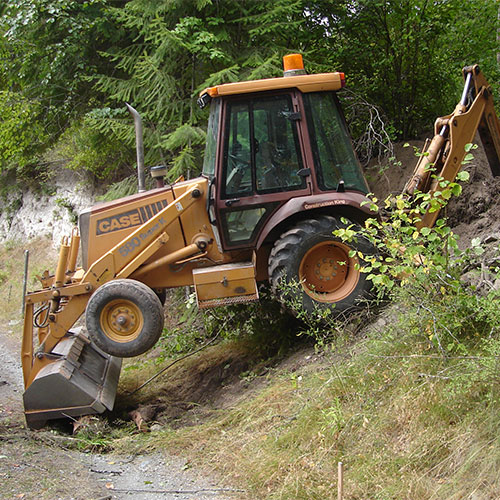Unveiling the Art of Excavation: Pro Tips for Safe and Productive Excavating
As dirt is transformed and planet is moved, the ins and outs of excavation reveal themselves, demanding an eager understanding of devices, dirt composition, security protocols, and ecological considerations. The knowledge required to navigate these aspects properly can imply the distinction between an effective excavation project and a prospective calamity.
Importance of Appropriate Tools
To make sure the safety and efficiency of any excavation project, using the suitable tools is critical. Excavation projects vary in scope and complexity, varying from tiny residential landscaping jobs to large-scale construction undertakings.
Excavators are fundamental pieces of machinery in any digging procedure. These functional makers been available in different sizes to fit different task needs. Tiny excavators are excellent for smaller sized jobs, while bigger excavators deal with more extensive tasks effectively. Backhoes are one more vital equipment type, incorporating the features of a loader and an excavator in one maker. They are important for jobs requiring versatility and ability to move.
Bulldozers stand out in jobs that require pushing large quantities of soil or particles. By spending in the proper tools, excavation jobs can be completed safely, on time, and with accuracy.
Recognizing Soil Structure
A comprehensive understanding of dirt make-up is fundamental for performing excavation jobs with accuracy and safety. Recognizing the various sorts of soil is vital as it straight influences excavation methods, devices option, and total task efficiency. Soil composition usually includes four primary elements: sand, silt, clay, and organic matter. Each element has special residential properties that affect how soil reacts to excavation procedures.
Silt bits are smaller than sand yet bigger than clay, providing moderate drainage and communication. Organic matter, such as decaying plant product, affects dirt fertility and security.
Prior to beginning excavation, conducting dirt tests to establish its structure and features is necessary. This info helps in choosing the suitable tools, executing security steps, and developing excavation methods tailored to the certain soil problems - excavating ohio. By understanding dirt composition, excavation experts can enhance job outcomes while guaranteeing safety and security and adherence to best techniques
Precaution and Protocols
Comprehending dirt make-up is the foundation whereupon safety procedures and methods for excavation projects are developed, guaranteeing the well-being of workers and the success of the undertaking. When it comes to security throughout excavation, there are numerous crucial measures that should be applied to mitigate risks and stop crashes.
Most importantly, prior to any digging commences, a detailed inspection of the site need to be carried out to identify any type of possible hazards such as below ground energies, unpredictable dirt problems, or neighboring frameworks that might posture a threat. It is crucial to have a skilled person supervise the excavation process to make certain that all safety protocols are followed purely.
Furthermore, all employees associated with the excavation should be appropriately learnt secure excavating practices and the proper procedure of tools. Individual safety equipment (PPE) such as hard hats, high visibility clothes, handwear covers, and security boots must be put on in all times to minimize the risk of injuries. dump truck companies in ohio. Regular security conferences and tool kit talks must likewise be carried septic ohio out to keep all workers educated about prospective dangers and strengthen risk-free work methods. By sticking to these precaution and methods, excavation tasks can be finished effectively and without event.
Reliable Excavation Preparation
When embarking on an excavation task, meticulous preparation is crucial to guarantee performance, security, and successful results. Effective excavation planning entails several essential actions that are vital for the smooth execution of the job.
As soon as the site evaluation is total, the following step is to produce a clear timeline and schedule for the excavation activities. This consists of establishing the sequence of tasks, devices needs, and manpower allowance. Correct scheduling helps prevent hold-ups and makes certain that the project remains on track.

In addition, interaction among all staff member is critical throughout the preparation stage. Clear instructions, normal updates, and reliable control are crucial for a successful excavation task. By spending effort and time in careful preparation, excavation teams can substantially enhance efficiency, reduce risks, and achieve effective end results.

Managing Ecological Considerations
With raising focus on environmental sustainability in building and construction methods, managing ecological considerations has actually become an important facet of excavation jobs. Excavation tasks have the prospective to influence the surrounding atmosphere via soil disintegration, debris drainage, habitat disturbance, and contamination of water sources. To alleviate these risks, it is vital to carry out best methods that focus on environmental management.

Moreover, appropriate waste administration is critical to stop dirt and water contamination. Implementing procedures for the disposal of harmful products, recycling of waste materials, and minimizing the usage of harmful chemicals can dramatically minimize the environmental influence of excavation projects. By integrating these methods into excavation planning and implementation, building and construction business can make certain that their jobs are not just secure and productive but also ecologically liable.
Verdict
In verdict, understanding the art of excavation needs a comprehensive understanding of correct equipment, dirt make-up, safety and security actions, and effective preparation. By complying with these guidelines and thinking about ecological elements, excavations can be performed securely and efficiently. It is important to focus on safety and performance in every digging project to ensure effective results.
As soil is turned and earth is moved, the complexities of excavation expose themselves, requiring an eager understanding of tools, dirt structure, security protocols, and environmental factors to consider.To make sure the safety and performance of any type of excavation job, making use of the suitable equipment is critical.A comprehensive grasp of soil composition is basic for carrying out excavation projects with accuracy and safety and security. Comprehending the different kinds of dirt is important as it directly affects excavation approaches, equipment selection, and total job effectiveness. By recognizing soil make-up, excavation specialists can boost job outcomes while guaranteeing safety and security and adherence to best techniques.